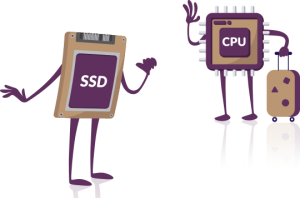New Partnership with RNT Rausch
We are proud to announce that our new partner RNT Rausch joined us in our journey to build on NVME capabilities to offer customers solutions that are simple, scalable, cost-efficient, and integrate with any orchestration system on any server or any cloud. #NVMEoverTCPIP #S3onNVME #Storageonsteroids

RNT Rausch is a Germany based technology pioneer with 20+ years of experience in the high tech server and storage industry. Their mission is to always be ahead of technology trends and rethink future-proof server and storage solution designs that go hybrid and tackle business challenges and makes SMBs, enterprises, data centres and service providers around the world fit for tomorrow’s technical revolution because our brain’s always on. RNT is making IT possible.
Free Your Flash And Disaggregate
Would you like some CPU to go along with your SSDs?
Ordering a combo meal from your favorite burger joint isn’t all that different from deploying a server with SSDs in the data center. Each server comes with CPUs, DRAM, and SSDs.
However, with servers, your applications may not have an appetite for all of these other components. A more likely scenario is where at least one of these resources mostly sits idle. In deployments with multiple SSD based applications, you are leaving money on the table—or leaving food on the plate, if we extend the combo meal metaphor—in the form of unused CPU, DRAM, or SSDs.

These underutilized CPUs, DRAM, and SSD resources are difficult to repurpose and become stranded resources, resulting in lost capital and operating expenditures. These purchased (or financed) resources consume power, real estate, and require cooling yet they don’t provide any useful benefit to the application. Reducing or eliminating stranded resources represents significant cost savings for your enterprise.
The major challenge has always been how to deploy CPU, DRAM, and flash resources in just the right quantities. Infrastructure architects employ different techniques to minimize the waste of these underutilized resources.
For instance, some architects use a large number of system configurations with each configuration matching a specific application. Deploying a large number of system configurations, however, comes with significant management and operational overhead, which doesn’t align with the operational efficiency of hyperscale data centers.
Another technique is to share storage using distributed storage software. But this method can result in a performance penalty when compared with direct attached storage. Many enterprise storage solutions offer high performance, but their cost is prohibitive for scale-out infrastructure.
It is essential to understand why architects go to great lengths to share resources with neighboring servers. This technique is known as disaggregation. Let us specifically focus on SSD disaggregation since technologies to effectively disaggregate SSDs exist today.